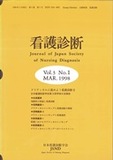Japanese
English
- 有料閲覧
- Abstract 文献概要
- 参考文献 Reference
看護診断の妥当性検討のための基礎資料を得るために,わが国での臨床におけるNANDA診断カテゴリーの使用状況に関する調査を行った.対象は臨床経験3年以上で,看護診断を使用した経験をもつ497名の看護婦である.109のNANDA看護診断を2つの側面(頻度と重要性)から評価した.頻度は1点の臨床で「まったく使わない」から,5点の「非常によく使う」までの5段階評定である.重要度は,1点の看護において「重要でない」から,5点の「とても重要である」までの5段階評定である.調査の結果,14項目の高頻度診断(頻度スコア>3.0)と22項目の高重要度診断(重要度スコア>3.5)が明らかになった.これらの診断の特徴は,比較的定義や介入もわかりやすく,具体的であると考えられる.両スケールの得点を加算して6点以上の項目を「高頻度・高重要度診断カテゴリー」としたところ,31項目が認められた.これらは1)〈疼痛〉,2)〈不安〉,3)〈感染のハイリスク状態〉,4)〈皮膚統合性の障害〉,5)〈便秘〉,6)〈知識不足〉,7)〈睡眠パターンの障害〉,8)〈入浴/清潔セルフケアの不足〉,9)〈排泄セルフケアの不足〉,10)〈更衣/整容セルフケアの不足〉の順であった.したがって日本において,早急にこれらの診断の妥当性検討を行う必要性が示唆された.
The purpose of this study is to examine the actual situation of the utilization of nursing diagnoses in Japan, and to obtain basic information for validation study. The sample was 497 nurses who have experience using nursing diagnosis. 109 NANDA's nursing diagnoses were evaluated in terms of frequency and importance. All of them were rated on a five-point scale; (5: very often use-1: never use)(5: very important-1: not important). There were 14 high frequency nursing diagnoses (frequency score>3.0) and 22 high importance nursing diagnoses (importance score>3.5). Those nursing diagnoses' definitions and interventions are thought to be clear and concrete. There were 31 nursing diagnoses which showed high frequency and importance (combined score>6.0); e.g., 1) Pain, 2) Anxiety, 3) High Risk for Infection, 4) Impaired Skin Integrity, 5) Constipation, 6) Knowledge Deficit, 7) Sleep Pattern Disturbance, 8) Bathing/Hygiene Self Care Deficit, 9) Toileting Self Care Deficit, 10) Dressing/Grooming Self Care Deficit. This suggests that it is necessary to conduct validation studies of these nursing diagnoses in Japan.
Copyright © 1998, Japan Society of Nursing Diagnosis. All rights reserved.


